belt JEEP WRANGLER UNLIMITED 2020 Owner handbook (in English)
[x] Cancel search | Manufacturer: JEEP, Model Year: 2020, Model line: WRANGLER UNLIMITED, Model: JEEP WRANGLER UNLIMITED 2020Pages: 330, PDF Size: 9.16 MB
Page 136 of 330
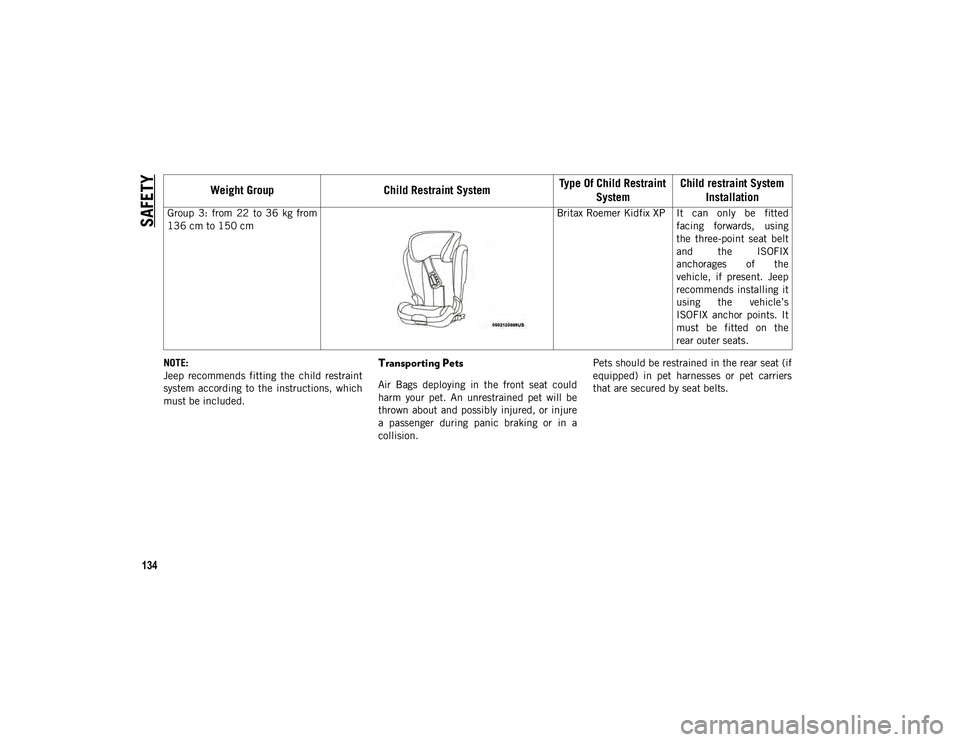
SAFETY
134
NOTE:
Jeep recommends fitting the child restraint
system according to the instructions, which
must be included.Transporting Pets
Air Bags deploying in the front seat could
harm your pet. An unrestrained pet will be
thrown about and possibly injured, or injure
a passenger during panic braking or in a
collision.Pets should be restrained in the rear seat (if
equipped) in pet harnesses or pet carriers
that are secured by seat belts.
Group 3: from 22 to 36 kg from
136 cm to 150 cm
Britax Roemer Kidfix XP It can only be fitted
facing forwards, using
the three-point seat belt
and the ISOFIX
anchorages of the
vehicle, if present. Jeep
recommends installing it
using the vehicle’s
ISOFIX anchor points. It
must be fitted on the
rear outer seats.
Weight Group Child Restraint System Type Of Child Restraint
System Child restraint System
Installation
2020_JEEP_JL_WRANGLER_UG_RHD_UK.book Page 134
Page 137 of 330

135
SAFETY TIPS
Transporting Passengers
NEVER TRANSPORT PASSENGERS IN THE
CARGO AREA.
Exhaust Gas The best protection against carbon monoxide
entry into the vehicle body is a properly
maintained engine exhaust system.
Whenever a change is noticed in the sound of
the exhaust system, when exhaust fumes can
be detected inside the vehicle, or when the
underside or rear of the vehicle is damaged,
have a competent mechanic inspect the
complete exhaust system and adjacent body
areas for broken, damaged, deteriorated, or
mispositioned parts. Open seams or loose
connections could permit exhaust fumes to
seep into the passenger compartment. In
addition, inspect the exhaust system each
time the vehicle is raised for lubrication or oil
change. Replace as required.
WARNING!
Do not leave children or animals inside
parked vehicles in hot weather. Interior
heat build-up may cause serious injury or
death.
It is extremely dangerous to ride in a
cargo area, inside or outside of a vehicle.
In a collision, people riding in these
areas are more likely to be seriously
injured or killed.
Do not allow people to ride in any area of
your vehicle that is not equipped with
seats and seat belts.
Be sure everyone in your vehicle is in a
seat and using a seat belt properly.
WARNING!
Exhaust gases can injure or kill. They
contain carbon monoxide (CO), which is
colorless and odorless. Breathing it can
make you unconscious and can eventually
poison you. To avoid breathing (CO), follow
these safety tips:
Do not run the engine in a closed garage or in
confined areas any longer than needed to
move your vehicle in or out of the area.
If you are required to drive with the trunk/lift-
gate/rear doors open, make sure that all
windows are closed and the climate control
BLOWER switch is set at high speed. DO NOT
use the recirculation mode.
If it is necessary to sit in a parked vehicle
with the engine running, adjust your
heating or cooling controls to force
outside air into the vehicle. Set the
blower at high speed.
2020_JEEP_JL_WRANGLER_UG_RHD_UK.book Page 135
Page 138 of 330
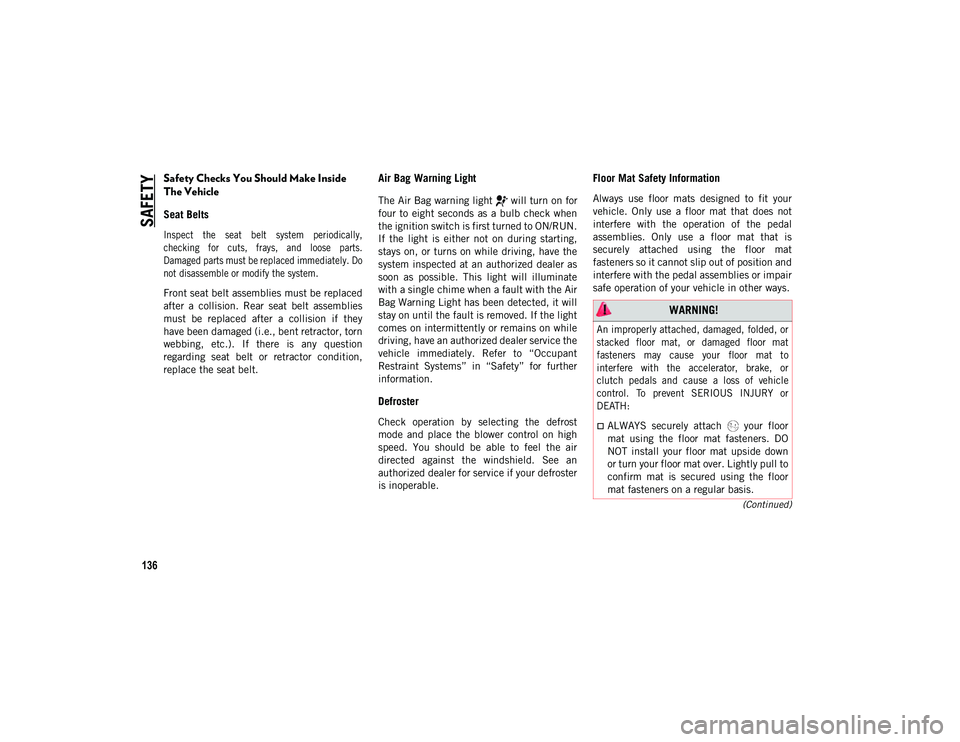
SAFETY
136
(Continued)
Safety Checks You Should Make Inside
The Vehicle
Seat Belts
Inspect the seat belt system periodically,
checking for cuts, frays, and loose parts.
Damaged parts must be replaced immediately. Do
not disassemble or modify the system.
Front seat belt assemblies must be replaced
after a collision. Rear seat belt assemblies
must be replaced after a collision if they
have been damaged (i.e., bent retractor, torn
webbing, etc.). If there is any question
regarding seat belt or retractor condition,
replace the seat belt.
Air Bag Warning Light
The Air Bag warning light will turn on for
four to eight seconds as a bulb check when
the ignition switch is first turned to ON/RUN.
If the light is either not on during starting,
stays on, or turns on while driving, have the
system inspected at an authorized dealer as
soon as possible. This light will illuminate
with a single chime when a fault with the Air
Bag Warning Light has been detected, it will
stay on until the fault is removed. If the light
comes on intermittently or remains on while
driving, have an authorized dealer service the
vehicle immediately. Refer to “Occupant
Restraint Systems” in “Safety” for further
information.
Defroster
Check operation by selecting the defrost
mode and place the blower control on high
speed. You should be able to feel the air
directed against the windshield. See an
authorized dealer for service if your defroster
is inoperable.
Floor Mat Safety Information
Always use floor mats designed to fit your
vehicle. Only use a floor mat that does not
interfere with the operation of the pedal
assemblies. Only use a floor mat that is
securely attached using the floor mat
fasteners so it cannot slip out of position and
interfere with the pedal assemblies or impair
safe operation of your vehicle in other ways.
WARNING!
An improperly attached, damaged, folded, or
stacked floor mat, or damaged floor mat
fasteners may cause your floor mat to
interfere with the accelerator, brake, or
clutch pedals and cause a loss of vehicle
control. To prevent SERIOUS INJURY or
DEATH:
ALWAYS securely attach your floor
mat using the floor mat fasteners. DO
NOT install your floor mat upside down
or turn your floor mat over. Lightly pull to
confirm mat is secured using the floor
mat fasteners on a regular basis.
2020_JEEP_JL_WRANGLER_UG_RHD_UK.book Page 136
Page 140 of 330
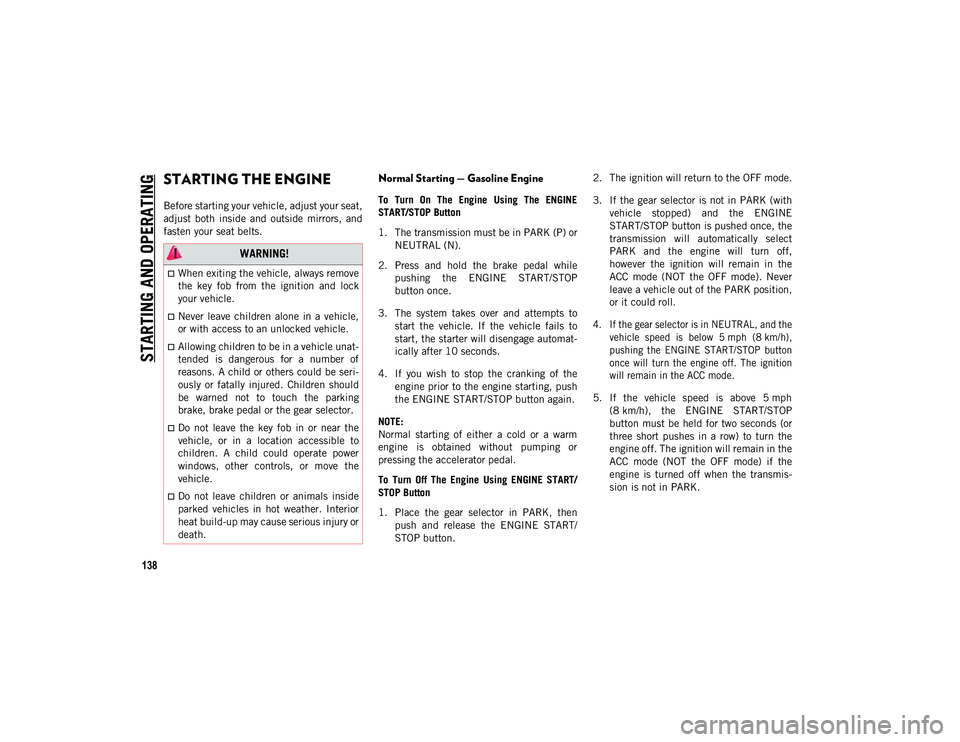
138
STARTING AND OPERATING
STARTING THE ENGINE
Before starting your vehicle, adjust your seat,
adjust both inside and outside mirrors, and
fasten your seat belts.
Normal Starting — Gasoline Engine
To Turn On The Engine Using The ENGINE
START/STOP Button
1. The transmission must be in PARK (P) orNEUTRAL (N).
2. Press and hold the brake pedal while pushing the ENGINE START/STOP
button once.
3. The system takes over and attempts to start the vehicle. If the vehicle fails to
start, the starter will disengage automat -
ically after 10 seconds.
4. If you wish to stop the cranking of the engine prior to the engine starting, push
the ENGINE START/STOP button again.
NOTE:
Normal starting of either a cold or a warm
engine is obtained without pumping or
pressing the accelerator pedal.
To Turn Off The Engine Using ENGINE START/
STOP Button
1. Place the gear selector in PARK, then push and release the ENGINE START/
STOP button. 2. The ignition will return to the OFF mode.
3. If the gear selector is not in PARK (with
vehicle stopped) and the ENGINE
START/STOP button is pushed once, the
transmission will automatically select
PARK and the engine will turn off,
however the ignition will remain in the
ACC mode (NOT the OFF mode). Never
leave a vehicle out of the PARK position,
or it could roll.
4. If the gear selector is in NEUTRAL, and the vehicle speed is below 5 mph (8 km/h),
pushing the ENGINE START/STOP button
once will turn the engine off. The ignition
will remain in the ACC mode.
5. If the vehicle speed is above 5 mph (8 km/h), the ENGINE START/STOP
button must be held for two seconds (or
three short pushes in a row) to turn the
engine off. The ignition will remain in the
ACC mode (NOT the OFF mode) if the
engine is turned off when the transmis -
sion is not in PARK.
WARNING!
When exiting the vehicle, always remove
the key fob from the ignition and lock
your vehicle.
Never leave children alone in a vehicle,
or with access to an unlocked vehicle.
Allowing children to be in a vehicle unat -
tended is dangerous for a number of
reasons. A child or others could be seri -
ously or fatally injured. Children should
be warned not to touch the parking
brake, brake pedal or the gear selector.
Do not leave the key fob in or near the
vehicle, or in a location accessible to
children. A child could operate power
windows, other controls, or move the
vehicle.
Do not leave children or animals inside
parked vehicles in hot weather. Interior
heat build-up may cause serious injury or
death.
2020_JEEP_JL_WRANGLER_UG_RHD_UK.book Page 138
Page 142 of 330
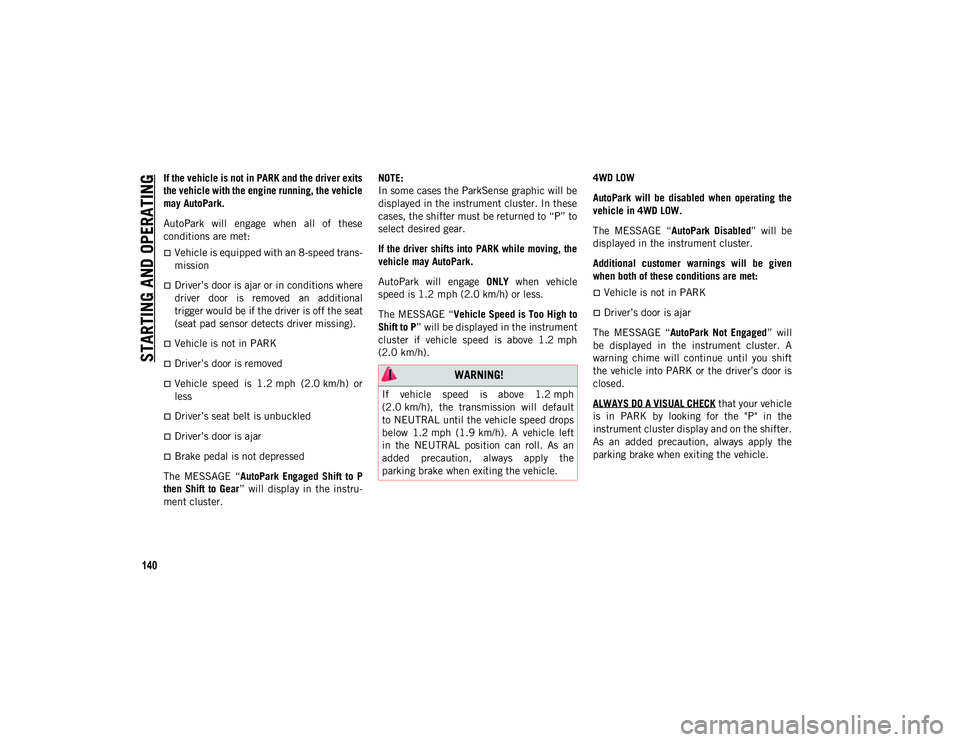
STARTING AND OPERATING
140
If the vehicle is not in PARK and the driver exits
the vehicle with the engine running, the vehicle
may AutoPark.
AutoPark will engage when all of these
conditions are met:
Vehicle is equipped with an 8-speed trans-
mission
Driver’s door is ajar or in conditions where
driver door is removed an additional
trigger would be if the driver is off the seat
(seat pad sensor detects driver missing).
Vehicle is not in PARK
Driver’s door is removed
Vehicle speed is 1.2 mph (2.0 km/h) orless
Driver’s seat belt is unbuckled
Driver’s door is ajar
Brake pedal is not depressed
The MESSAGE “AutoPark Engaged Shift to P
then Shift to Gear ” will display in the instru -
ment cluster. NOTE:
In some cases the ParkSense graphic will be
displayed in the instrument cluster. In these
cases, the shifter must be returned to “P” to
select desired gear.
If the driver shifts into PARK while moving, the
vehicle may AutoPark.
AutoPark will engage
ONLY when vehicle
speed is 1.2 mph (2.0 km/h) or less.
The MESSAGE “Vehicle Speed is Too High to
Shift to P ” will be displayed in the instrument
cluster if vehicle speed is above 1.2 mph
(2.0 km/h). 4WD LOW
AutoPark will be disabled when operating the
vehicle in 4WD LOW.
The MESSAGE “
AutoPark Disabled ” will be
displayed in the instrument cluster.
Additional customer warnings will be given
when both of these conditions are met:
Vehicle is not in PARK
Driver’s door is ajar
The MESSAGE “ AutoPark Not Engaged ” will
be displayed in the instrument cluster. A
warning chime will continue until you shift
the vehicle into PARK or the driver’s door is
closed.
ALWAYS DO A VISUAL CHECK
that your vehicle
is in PARK by looking for the "P" in the
instrument cluster display and on the shifter.
As an added precaution, always apply the
parking brake when exiting the vehicle.
WARNING!
If vehicle speed is above 1.2 mph
(2.0 km/h), the transmission will default
to NEUTRAL until the vehicle speed drops
below 1.2 mph (1.9 km/h). A vehicle left
in the NEUTRAL position can roll. As an
added precaution, always apply the
parking brake when exiting the vehicle.
2020_JEEP_JL_WRANGLER_UG_RHD_UK.book Page 140
Page 156 of 330

STARTING AND OPERATING
154
Automatic Mode
The Stop/Start feature is enabled
after every normal customer engine
start. At that time, the system will
go into STOP/START READY and if
all other conditions are met, can go into a
STOP/START AUTOSTOP ACTIVE
“Autostop” mode.
To Activate The Autostop Mode, The Following
Must Occur:
The system must be in STOP/START
READY state. A STOP/START READY
message will be displayed in the instru -
ment cluster display within the Stop/Start
section. Refer to “Instrument Cluster” in
“Getting To Know Your Instrument Panel”
in your Owner’s Manual for further infor -
mation.
The vehicle must be completely stopped.
The shifter must be in a forward gear and
the brake pedal depressed.
The engine will shut down, the tachometer
will move to the zero position and the Stop/
Start telltale will illuminate indicating you
are in Autostop. Customer settings will be
maintained upon return to an engine running
condition. Refer to the “Stop/Start System” in the
“Starting And Operating” section located in
your Owner’s Manual for further information.
Possible Reasons The Engine Does Not
Autostop
Prior to engine shut down, the system will
check many safety and comfort conditions to
see if they are fulfilled. Detailed information
about the operation of the Stop/Start system
may be viewed in the instrument cluster
display Stop/Start Screen. In the following
situations, the engine will not stop:
Driver’s seat belt is not buckled.
Driver’s door is not closed.
Battery temperature is too warm or cold.
Battery charge is low.
The vehicle is on a steep grade.
Cabin heating or cooling is in process and
an acceptable cabin temperature has not
been achieved.
HVAC is set to full defrost mode at a high
blower speed.
HVAC set to MAX A/C.
Engine has not reached normal operating
temperature.
Engine temperature too high.
The transmission is not in a forward gear.
Hood is open.
Transfer case is in 4L or Neutral.
Brake pedal is not pressed with sufficient
pressure.
Other Factors Which Can Inhibit Autostop
Include:
Accelerator pedal input.
Vehicle speed threshold not achieved from
previous auto-stop.
Steering angle beyond threshold. (ESS
Models Only)
ACC is on and speed is set.
Vehicle is at high altitude.
System fault present.
It may be possible for the vehicle to be driven
several times without the Stop/Start system
going into a STOP/START READY state
under more extreme conditions of the items
listed above.
2020_JEEP_JL_WRANGLER_UG_RHD_UK.book Page 154
Page 189 of 330
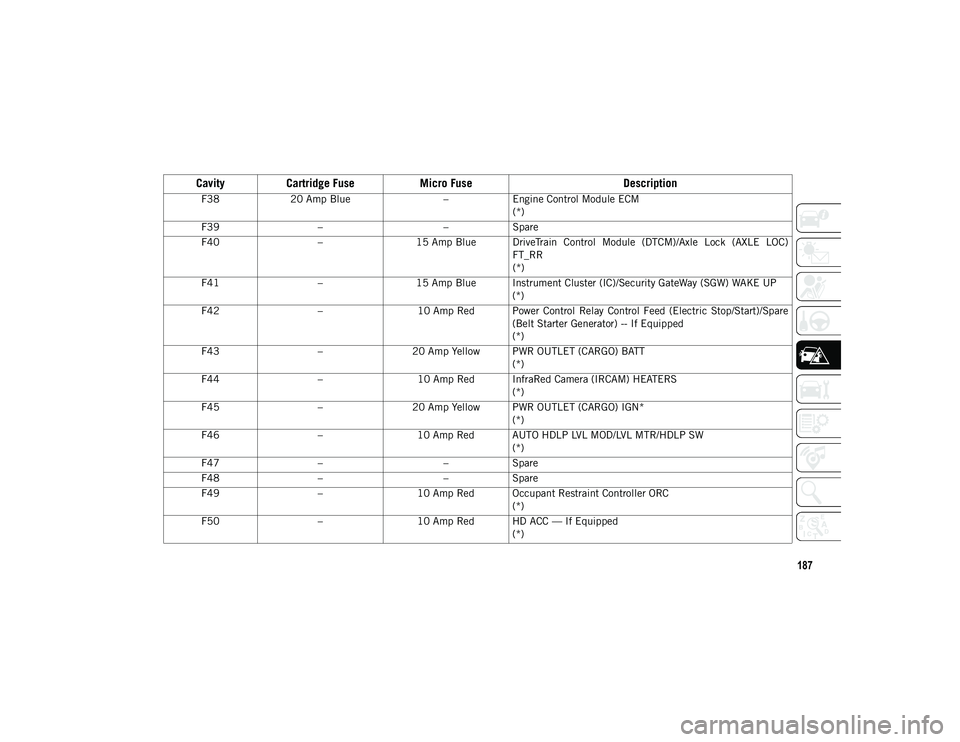
187
F38 20 Amp Blue
–Engine Control Module ECM
(*)
F39 – –Spare
F40 –15 Amp Blue DriveTrain Control Module (DTCM)/Axle Lock (AXLE LOC)
FT_RR
(*)
F41 –15 Amp Blue Instrument Cluster (IC)/Security GateWay (SGW) WAKE UP
(*)
F42 –10 Amp Red Power Control Relay Control Feed (Electric Stop/Start)/Spare
(Belt Starter Generator) -- If Equipped
(*)
F43 –20 Amp Yellow PWR OUTLET (CARGO) BATT
(*)
F44 –10 Amp Red InfraRed Camera (IRCAM) HEATERS
(*)
F45 –20 Amp Yellow PWR OUTLET (CARGO) IGN*
(*)
F46 –10 Amp Red AUTO HDLP LVL MOD/LVL MTR/HDLP SW
(*)
F47 – –Spare
F48 – –Spare
F49 –10 Amp Red Occupant Restraint Controller ORC
(*)
F50 –10 Amp Red HD ACC — If Equipped
(*)
CavityCartridge Fuse Micro Fuse Description
2020_JEEP_JL_WRANGLER_UG_RHD_UK.book Page 187
Page 191 of 330
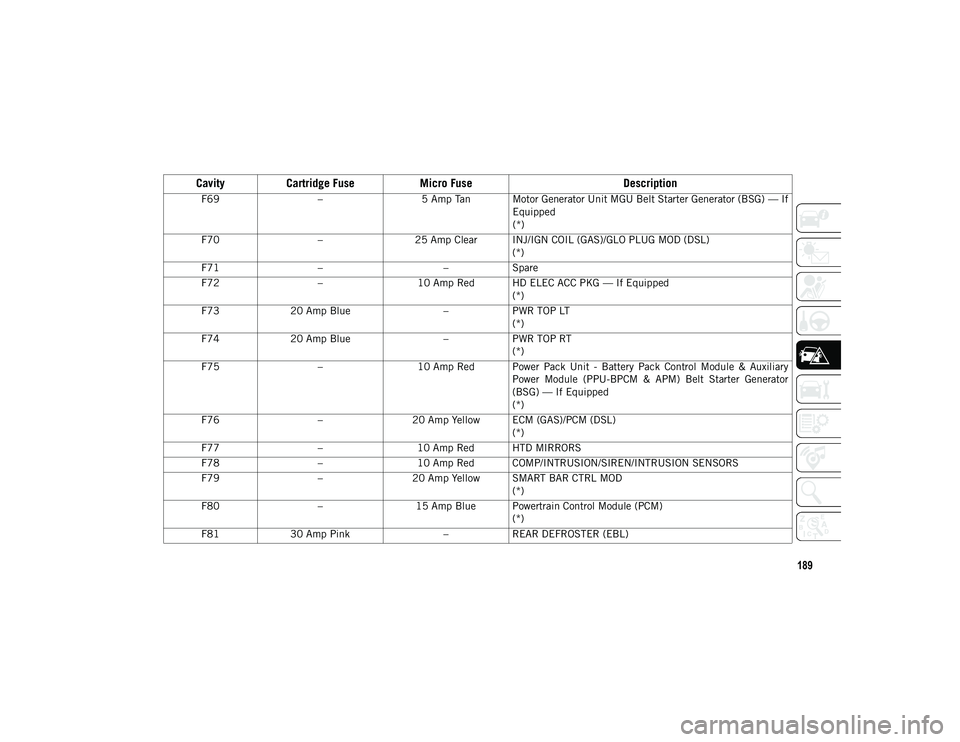
189
F69–5 Amp Tan Motor Generator Unit MGU Belt Starter Generator (BSG) — If
Equipped
(*)
F70 –25 Amp Clear INJ/IGN COIL (GAS)/GLO PLUG MOD (DSL)
(*)
F71 – –Spare
F72 –10 Amp Red HD ELEC ACC PKG — If Equipped
(*)
F73 20 Amp Blue –PWR TOP LT
(*)
F74 20 Amp Blue –PWR TOP RT
(*)
F75 –10 Amp Red Power Pack Unit - Battery Pack Control Module & Auxiliary
Power Module (PPU-BPCM & APM) Belt Starter Generator
(BSG) — If Equipped
(*)
F76 –20 Amp Yellow ECM (GAS)/PCM (DSL)
(*)
F77 –10 Amp Red HTD MIRRORS
F78 –10 Amp Red COMP/INTRUSION/SIREN/INTRUSION SENSORS
F79 –20 Amp Yellow SMART BAR CTRL MOD
(*)
F80 –15 Amp Blue Powertrain Control Module (PCM)
(*)
F81 30 Amp Pink –REAR DEFROSTER (EBL)
Cavity Cartridge Fuse Micro Fuse Description
2020_JEEP_JL_WRANGLER_UG_RHD_UK.book Page 189
Page 217 of 330
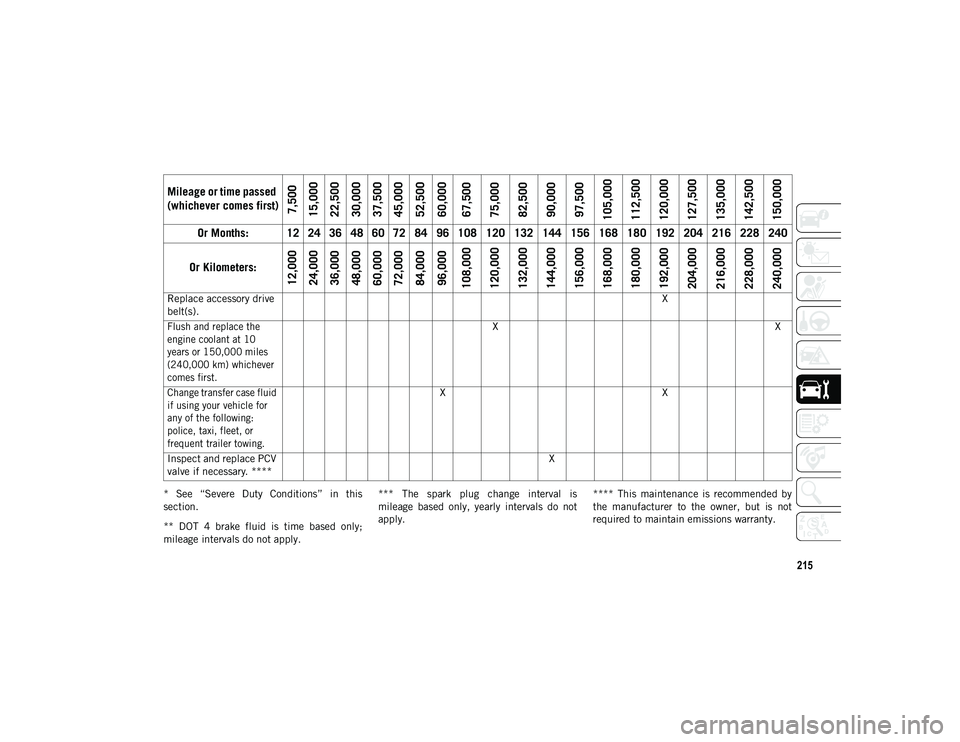
215
* See “Severe Duty Conditions” in this
section.
** DOT 4 brake fluid is time based only;
mileage intervals do not apply.*** The spark plug change interval is
mileage based only, yearly intervals do not
apply.
**** This maintenance is recommended by
the manufacturer to the owner, but is not
required to maintain emissions warranty.
Replace accessory drive
belt(s).
X
Flush and replace the
engine coolant at 10
years or 150,000 miles
(240,000 km) whichever
comes first.
X
X
Change transfer case fluid
if using your vehicle for
any of the following:
police, taxi, fleet, or
frequent trailer towing.
X
X
Inspect and replace PCV
valve if necessary. **** X
Mileage or time passed
(whichever comes first)
7,500
15,000
22,500
30,000
37,500
45,000
52,500
60,000
67,500
75,000
82,500
90,000
97,500
105,000
112,500
120,000
127,500
135,000
142,500
150,000
Or Months: 12 24 36 48 60 72 84 96 108 120 132 144 156 168 180 192 204 216 228 240
Or Kilometers:
12,000
24,000
36,000
48,000
60,000
72,000
84,000
96,000
108,000
120,000
132,000
144,000
156,000
168,000
180,000
192,000
204,000
216,000
228,000
240,000
2020_JEEP_JL_WRANGLER_UG_RHD_UK.book Page 215
Page 218 of 330
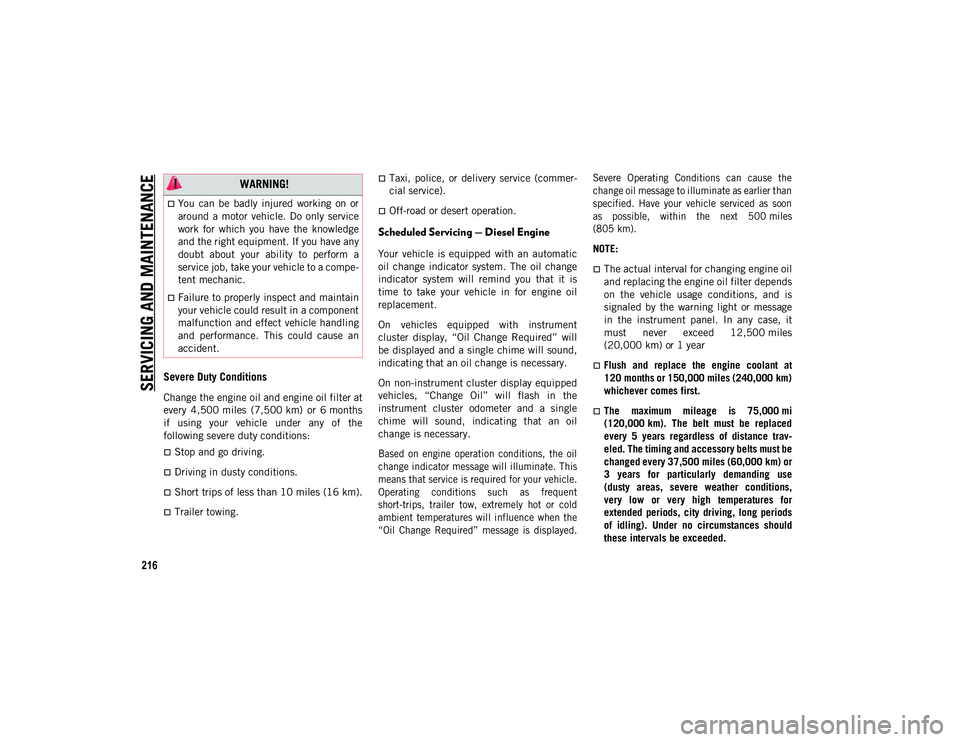
SERVICING AND MAINTENANCE
216
Severe Duty Conditions
Change the engine oil and engine oil filter at
every 4,500 miles (7,500 km) or 6 months
if using your vehicle under any of the
following severe duty conditions:
Stop and go driving.
Driving in dusty conditions.
Short trips of less than 10 miles (16 km).
Trailer towing.
Taxi, police, or delivery service (commer-
cial service).
Off-road or desert operation.
Scheduled Servicing — Diesel Engine
Your vehicle is equipped with an automatic
oil change indicator system. The oil change
indicator system will remind you that it is
time to take your vehicle in for engine oil
replacement.
On vehicles equipped with instrument
cluster display, “Oil Change Required” will
be displayed and a single chime will sound,
indicating that an oil change is necessary.
On non-instrument cluster display equipped
vehicles, “Change Oil” will flash in the
instrument cluster odometer and a single
chime will sound, indicating that an oil
change is necessary.
Based on engine operation conditions, the oil
change indicator message will illuminate. This
means that service is required for your vehicle.
Operating conditions such as frequent
short-trips, trailer tow, extremely hot or cold
ambient temperatures will influence when the
“Oil Change Required” message is displayed. Severe Operating Conditions can cause the
change oil message to illuminate as earlier than
specified. Have your vehicle serviced as soon
as possible, within the next 500 miles
(805 km).
NOTE:
The actual interval for changing engine oil
and replacing the engine oil filter depends
on the vehicle usage conditions, and is
signaled by the warning light or message
in the instrument panel. In any case, it
must never exceed 12,500 miles
(20,000 km) or 1 year
Flush and replace the engine coolant at
120 months or 150,000 miles (240,000 km)
whichever comes first.
The maximum mileage is 75,000 mi
(120,000 km). The belt must be replaced
every 5 years regardless of distance trav-
eled. The timing and accessory belts must be
changed every 37,500 miles (60,000 km) or
3 years for particularly demanding use
(dusty areas, severe weather conditions,
very low or very high temperatures for
extended periods, city driving, long periods
of idling). Under no circumstances should
these intervals be exceeded.
WARNING!
You can be badly injured working on or
around a motor vehicle. Do only service
work for which you have the knowledge
and the right equipment. If you have any
doubt about your ability to perform a
service job, take your vehicle to a compe-
tent mechanic.
Failure to properly inspect and maintain
your vehicle could result in a component
malfunction and effect vehicle handling
and performance. This could cause an
accident.
2020_JEEP_JL_WRANGLER_UG_RHD_UK.book Page 216